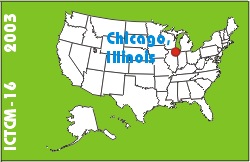
Electronic Proceedings of the Sixteenth Annual International Conference on Technology in Collegiate MathematicsChicago, Illinois, October 30-November 2, 2003Paper C019Interactive Web-Based Calculus Projects at Hollins University: Area of U.S. States and Roller Coasters |
Julie ClarkDepartment of Mathematics and Statistics Hollins University PO Box 9681 Roanoke, VA 24020 USA Phone: (540) 362-6524 jclark@hollins.edu list of all papers by this author | Trish HammerDepartment of Mathematics and Statistics Hollins University PO Box 9681 Roanoke, VA 24020 USA Phone: (540) 362-6599 phammer@hollins.edu list of all papers by this author |
| Click to access this paper: |
ABSTRACT
In the mathematics and statistics curriculums at Hollins University and Virginia Western Community College, there is much emphasis on the application of concepts to real life problems. For this purpose, we have recently developed two interactive web-based calculus projects which use JAVA applets as well as downloadable Maple worksheets. These projects are original and exciting and have been well received by both students and colleagues. The first project was developed for Calculus II during an online PREP workshop sponsored by the MAA and NSF in July 2002, and was recently published in The Journal of Online Mathematics and Its Applications. In this project, students use an interactive on-line map of Virginia to collect data points along the border and then import these values into a downloadable Maple worksheet. This worksheet is complete with the commands (plot, solve, integrate, do loops) necessary for visual and mathematical construction of the area approximations. Four approximation methods are presented, progressing from rectangular and trapezoidal rules to the more complex Simpson's rule. As a project assignment, students are required to use these ideas to approximate the area of one of four given states (California, Illinois, Maryland, or North Carolina). The geometric shapes of these states (in comparison with Virginia) suggest significant and interesting modifications of the Virginia procedure. We will showcase not only the original project but also recently submitted and widely varied student solutions.In the second project, developed for Calculus I students, the emphasis is on application of derivatives. Students develop a more thorough understanding of slope, local maximum and minimum points, and points of inflection by applying these concepts to straight stretch roller coasters. Students use interactive online images of real roller coasters to identify peak and valley points and also to determine the points of steepest ascent and descent. Then students determine the 'thrill' (as defined in the project) of these coasters. Student use downloadable Maple worksheets to design and mathematically model straight stretch coasters (given certain coaster restrictions) and to determine the corresponding thrill. Cubic polynomial functions and trigonometric functions are used to model the paths of these single drop and several drop coasters. As a project assignment, students are asked to mathematically design a coaster which satisfies the given restrictions and that has the maximum thrill. We will showcase this exciting project along with possible solutions.
Keyword(s): calculus, Internet, applications
